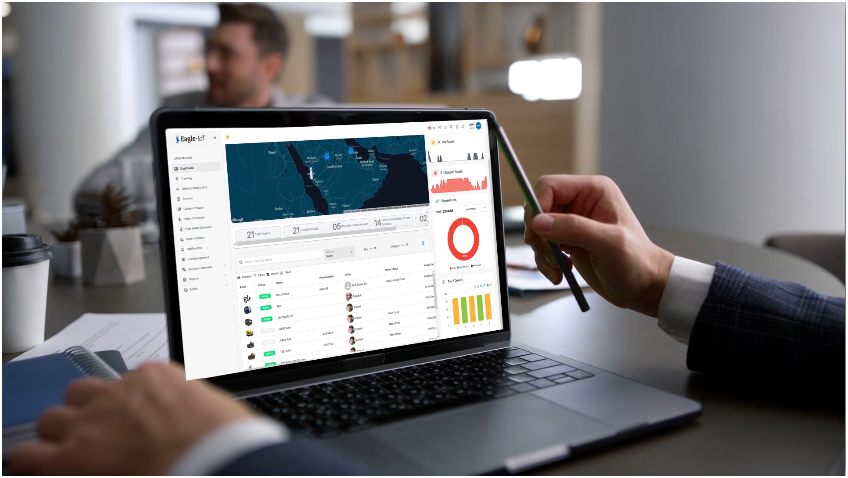From Dots on a Map to Business Intelligence: The Evolution of GPS Vehicle Tracking
In its early days, GPS vehicle tracking was little more than a way to see “dots on a map.” Fleet managers could use these dots to visualize vehicle locations, offering basic insights into where their assets were in real time. Over the past decade, however, GPS tracking has undergone a significant transformation, evolving from a simple location service into a powerful tool that addresses complex business challenges. The modern fleet management landscape is driven by technology that offers detailed insights into operations, driver behavior, and asset management.
Here’s how GPS vehicle tracking has evolved from basic positioning to a sophisticated business solution.
The Early Days: Dots on a Map
When GPS tracking first became widely available for commercial use in the early 2000s, its capabilities were fairly rudimentary. Companies could monitor the real-time location of their vehicles via satellite signals. The “dots on a map” approach allowed businesses to track their assets’ movements but offered limited functionality beyond this. For industries like logistics and transportation, this was already a huge improvement. Businesses could ensure that vehicles followed predetermined routes, keep tabs on arrival times, and prevent theft. But these early systems didn’t provide insights into operational efficiency, driver behavior, or ways to reduce costs—data that are now essential for modern fleet management.

Real-Time Alerts: The First Leap
As GPS technology advanced, tracking systems incorporated real-time alerts for more proactive management. Instead of simply monitoring vehicles, fleet managers could now receive alerts for critical events such as speeding, unauthorized usage, or deviations from planned routes. This development allowed companies to improve driver safety and reduce unnecessary expenses by addressing problems immediately.

These notifications also opened the door to more detailed analytics. Companies could compare how different drivers or routes impacted performance, giving them a clearer understanding of the factors that influenced fuel consumption, vehicle wear and tear, and operational efficiency.
Integration with Telematics: A Game-Changer
The real turning point came when GPS tracking systems began integrating with telematics—technology that collects and transmits vehicle data such as fuel consumption, engine health, and driver behavior. Telematics allows fleet managers to go beyond location tracking and gain deep insights into how their vehicles are being used.
With this data, companies can now identify patterns and trends in fleet performance. For instance, they can monitor fuel efficiency by tracking idle times, detect maintenance issues through engine diagnostics, and promote safer driving habits by analyzing behaviors such as harsh braking or aggressive acceleration. Telematics also enables businesses to set up geofences—virtual boundaries around specific areas. If a vehicle enters or exits a geofenced zone, the system sends an alert, adding another layer of security and accountability for fleets.
Solving Complex Business Challenges
As GPS vehicle tracking has evolved, it has moved from simply showing a vehicle’s location to solving intricate business challenges. Here’s how:
1. Operational Efficiency
Today’s GPS solutions integrate with route optimization tools, allowing fleets to design the most efficient routes for their vehicles. They can consider factors like traffic patterns, delivery schedules, and fuel costs to streamline operations. This shift has been particularly important for industries like transportation and delivery services, where small changes in route efficiency can have a significant impact on profitability.

2. Cost Management
Fuel and maintenance represent some of the biggest costs for any fleet. Modern GPS tracking systems, combined with telematics, help businesses monitor fuel consumption and detect waste, such as excessive idling or inefficient routes. They also track engine diagnostics in real time, enabling proactive maintenance that reduces vehicle downtime and expensive repairs.
For example, identifying a vehicle that’s due for preventive maintenance before it breaks down helps companies avoid costly repairs and service delays.

3. Driver Safety and Behavior
Driver behavior plays a crucial role in fleet safety and efficiency. Today’s GPS tracking systems come with driver scorecards that evaluate driving habits like speeding, harsh braking, and sudden accelerations. By providing real-time feedback and driver coaching based on this data, businesses can reduce the likelihood of accidents, lower insurance premiums, and ensure that their drivers are operating in a safe, fuel-efficient manner.
4. Compliance and Reporting
As regulations surrounding vehicle fleets have increased, GPS tracking systems have evolved to meet compliance needs. Modern systems automatically track drivers’ hours, ensure compliance with regulations, and store data for easy reporting, reducing administrative workloads and minimizing the risk of violations.
Overcoming Barriers to Adoption
While GPS vehicle tracking has come a long way, many companies still face barriers to fully utilizing these advanced solutions. Some fleet operators are concerned about costs, while others worry about privacy issues related to constant monitoring. However, the return on investment (ROI) from modern GPS tracking solutions quickly outweighs these concerns. By reducing fuel waste, improving driver safety, and optimizing maintenance schedules, businesses can see significant savings. Additionally, transparent communication with drivers about the benefits of tracking—such as improving safety and protecting against wrongful claims—helps mitigate concerns over privacy.

The Role of AI and Predictive Analytics
The future of GPS vehicle tracking lies in artificial intelligence (AI) and predictive analytics. AI-powered systems can analyze vast amounts of telematics data to predict issues before they arise. For example, predictive maintenance alerts based on real-time engine diagnostics can reduce downtime by recommending service before a vehicle breaks down. Similarly, AI can analyze traffic patterns and driver behavior to suggest safer, more efficient routes.
Moreover, machine learning algorithms are being used to refine driver behavior analysis, making it easier for businesses to implement training programs that focus on long-term improvements rather than one-off corrections.
How Eagle-IoT Elevates GPS Tracking
Eagle-IoT’s telematics platform leverages advanced GPS vehicle tracking technology to help businesses overcome today’s complex fleet challenges. With real-time tracking, driver behavior monitoring, and comprehensive vehicle diagnostics, Eagle-IoT provides companies with actionable insights that drive better decision-making.

Case studies from Eagle-IoT customers have shown reductions in fuel costs, improvements in driver safety, and a significant boost in operational efficiency. By predicting potential issues, optimizing routes, and enhancing overall fleet performance, Eagle-IoT empowers businesses to maximize their assets and reduce costs, all while improving safety and compliance. GPS vehicle tracking has evolved far beyond simple location monitoring. With the integration of telematics, real-time data, and AI-driven analytics, businesses can now leverage these technologies to solve complex operational challenges, improve safety, and significantly reduce costs. The future of fleet management lies in unlocking the full potential of these tools.

